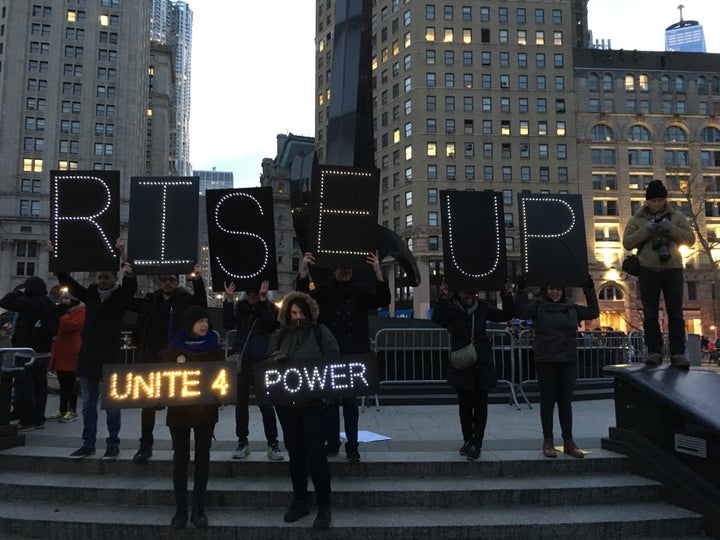
Demonstrators gather at Foley Square in Lower Manhattan on January 29, 2016, after an anti-Trump march from Battery Park.
During an unpredictable Trumpist era, protests have solidified the opposition movement.
The marches, rallies, and demonstrations have hit the streets of large American cities in waves. The Women’s March, with local chapters gathering from Alaska to Antarctica, turned into the biggest single day of protest in U.S. history. Since then, the protests have mostly focused on resistance to the Executive Order cracking down on immigration, first at airports and then beyond.
On the one hand, President Donald Trump is charging forward with his bold, alt-Republican agenda: lowering corporate taxes, scrapping trade deals, and gutting Obamacare.
But while some anti-Trump partisans bemoan that the first three weeks of his administration have been the “longest” ever, Democratic and progressive activists have rather successfully firmed up the foundation of a long-term resistance movement. Shall we call this liberal version of the Tea Party the “D Party” to represent the Dems, or the “P Party” to emphasize progressive bona fides?
A huge surge of energy on the left and rapid political mobilization have meant an uptick in phone calls, letters, and petitions to legislators who have the constitutional power to challenge Trump’s policies.
The massive grassroots outpouring, including many who were politically dormant, has fed off fears that Trump poses an existential threat to cherished aspects of American society. Yet the fact that millions were only activated after the election has led to charges that the protesters are being paid, inorganically, to show up, and questions about why they didn’t come out sooner.
And like the Tea Party of yesteryear, the protesters plan to go the distance, enraged as much by the shortcomings of lawmakers on their side of the aisle as by the flawed ideas of those on the other side. Meanwhile, many naysayers say that the violent actions of a few extremist protesters invalidate the principles of the movement as a whole.
Ideologically, the resistance has coalesced around liberal Democrats, largely female, who often argue that the president is illegitimate. They fear the incipient combination of ethnonationalism, reckless populism, and fiscal conservatism in Trump’s administration.
Notable accomplishments thus far include Congressional restoration of ethics office power; slow confirmation of cabinet nominees; postponement of plans to privatize Medicare and public lands; exemption of the Veterans’ Administration from the federal hiring freeze; and endangerment of Republican effort to disable the Affordable Care Act.
By far, the most significant victories for those opposing the White House’s actions are the exclusion of 500,000 green-card holders from the seven-country immigration ban and the series judicial rulings against the ban’s core tenets. Dual citizens and immigrants who worked with the U.S. military have also largely skirted the restrictions.
Public outcry seems to have played a major role. The Nation described the shift as an “explosion of new activism [that] offers a ray of hope in these dark political times.”
The GOP is also facing widespread anger over its moves to repeal and replace Obamacare. Voters are agitating in a way that continues to be hard to ignore. The fight over protections for DREAMers will likely proceed from the same wellspring of indignation.
Here are a few of the notable grassroots efforts that have been born since November, as many different organizations hope to capture media attention and capitalize on the political moment:
Indivisible
“A practical guide for resisting the Trump agenda” has made it to the forefront of the various projects opposing the president. With over a 1.5 million downloads of the Indivisible pamphlet, over 200,000 people registered, and 5,300 groups signed up in every state, the organization is poised to lead the pack.
Their mission is focused on educating and motivating citizens to contact and lobby their representatives, and it’s being touted as a way for “former congressional staffers [to] reveal best practices for making Congress listen.”
On its website, Indivisible says: “We want to provide shared tools to help groups organize events, communicate with each other...This also means spotlighting local successes and supporting a sense of a shared purpose.”
Swing Left
This group focuses on the path towards winning more races at the polls during the next midterms. “Control of the House in 2018 will be decided by a handful of Swing Districts, places where the last election was decided by a thin margin,” says the Swing Left website.
The organization’s target is winning 80 percent of the 52 races considered most competitive. Although achieving Democratic control of the House in two years will not be easy, it’s certainly one of the most important components of the big-picture progressive strategy. Having enlisted the help of over a quarter-million Americans, the group is still looking for more volunteers and funding.
#KNOCKEVERYDOOR
The premise of this new outfit is that Democrats failed to engage voters in the streets during the 2016 campaign. So the #KNOCKEVERYDOOR goal, formulated by a group of former Bernie Sanders staffers, is to reach disenfranchised and discouraged voters who were barely involved in the political process before.
One of the key parts of the project is that unpaid canvassers should be trusted to carry out the functions of grassroots outreach, rather than relying on professional field organizers who require a substantial budget to sustain.
Similar groups include fundraising tool Movement2017, pink headwear pioneer PUSSYHAT PROJECT, and activist network MOVEMENT MATCH.
There are innumerable other progressive organizations that have recently launched, such as TownHallProject, #ResistTrumpTuesdays, Justice Democrats, and District 13. Impeach Trump Now and Buycott Trump are two additional movements with self-evident messages.
